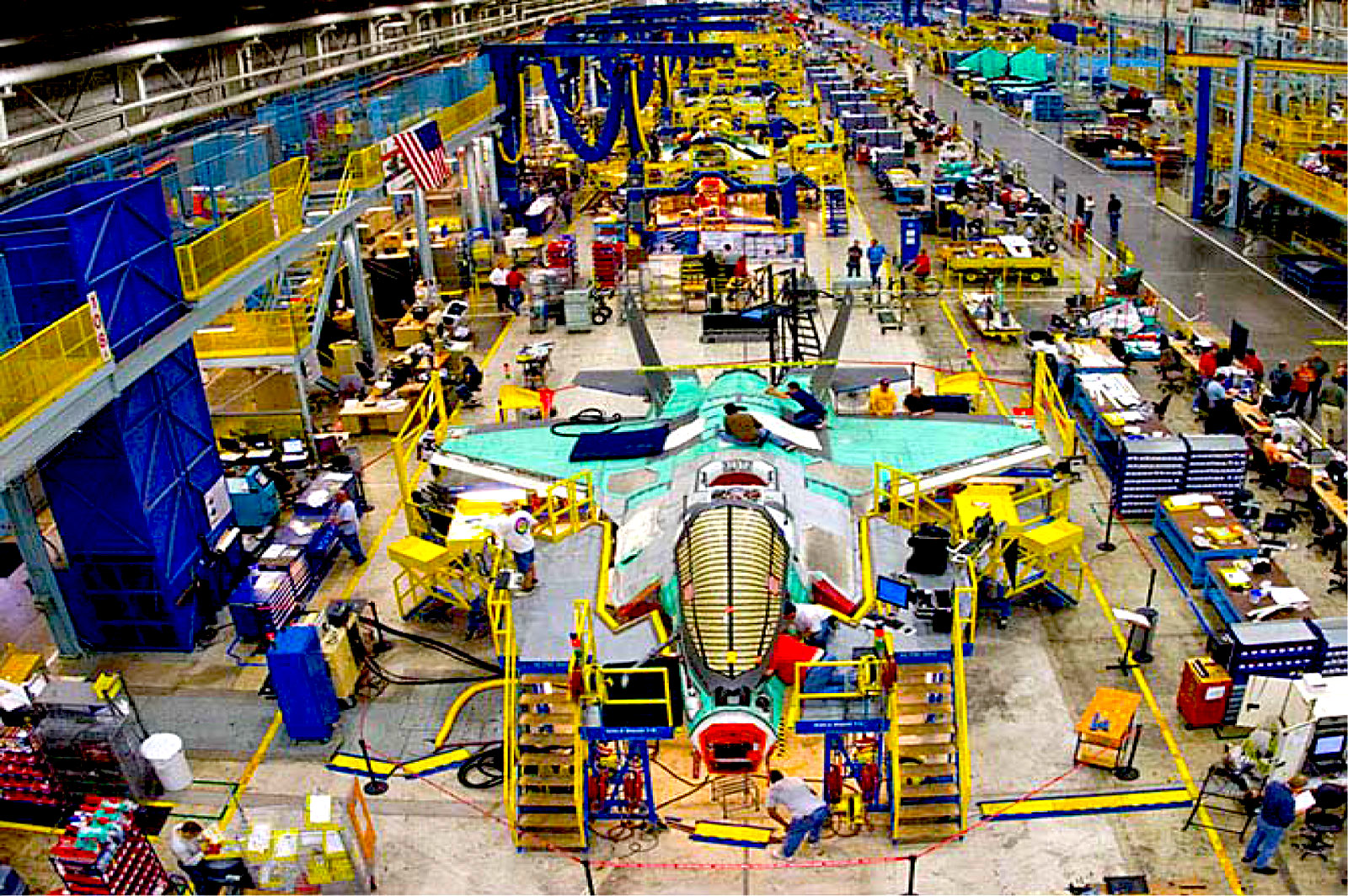Any modern-day probe of U.S. war profiteering could start by reviewing the 1936 conclusions of a special Senate investigation, writes Sam Pizzigati.

April 5, 2013: Code Pink activist japes General Atomics’ CEO Neal Blue during anti-drone protest outside the weapon maker’s San Diego headquarters. Banner in background: “General Atomics Thanks Barack Obama.” (Steve Rhodes, Flickr, CC BY-NC-ND 2.0)
By Sam Pizzigati
Inequality.org
 We denizens of the 21st century have become somewhat accustomed — inured might be the better word — to the murderous mass violence of modern warfare.
We denizens of the 21st century have become somewhat accustomed — inured might be the better word — to the murderous mass violence of modern warfare.
We shouldn’t find that at all surprising. The 20th century rates as the deadliest century in human history. Upwards of 75 million people died in World War II alone. Millions more have died in “little” wars since, including the nearly quarter-million who perished during the 20 years of the U.S. military war on Afghanistan.
But for our forbears, back in the early decades of the 20th century, the incredible deadliness of modern warfare came as something of a shock. The carnage of World War I — with its 40 million dead — left people worldwide searching for new international arrangements that could prevent any repeat of modern war’s horror.

Council of Four at the WWI Paris peace conference, May 27, 1919: left to right, British Prime Minister David Lloyd George, Italian Premier Vittorio Orlando; French Premier Georges Clemenceau, U.S. President Woodrow Wilson. (Edward N. Jackson, U.S. Signal Corps, Wikimedia Commons)
The Paris Peace Conference of 1919 launched the League of Nations and sparked a series of additional global parleys. The Washington Disarmament Conference of 1922. The Geneva Arms Control Conference of 1925. The Geneva Disarmament Conference of 1927.
In 1928, the world’s top nations even signed an agreement that renounced war as an instrument of national policy.
‘Follow the Money’
All these steps would prove hopelessly inadequate to the task at hand. By the mid-1930s the world was swimming in a weapons-of-war sea, and people still reeling from World War I wanted to know why.
In the United States, peace-seekers would “follow the money” to find out.
Many American moguls, they soon realized, were getting ever richer off prepping for war. These “merchants of death” — the era’s strikingly vivid label for war profiteers — had a vested interest in perpetuating the sorts of arms races that make wars more likely.
Millions of Americans believed the country needed to take the profit out of war.
On Capitol Hill, the Democratic Senate majority set up a special committee to investigate the munitions industry and named a progressive Republican, North Dakota’s Gerald Nye, to chair it. “War and preparation for war,” Nye noted at the panel’s founding in 1934, had precious little to do with either “national honor” or “national defense.” War had become “a matter of profit for the few.”
The problem Nye named remains. Contemporary corporate moguls are continuing to get rich off the preparations that make wars more likely and massively multiply death counts when the shooting starts.
America’s longest war — the war in Afghanistan — offers but the latest example.

Sen. Gerald Nye, at left, with Sen. Henry Cabot Lodge Jr. in 1937. Both had joined the bloc of U.S. senators calling on President Franklin D. Roosevelt to invoke the Neutrality Act to keep the U.S. out of the Sino-Japanese conflict. (Harris & Ewing, Library of Congress, Wikimedia Commons)
We won’t know for some time the total haul of our corporate executive class from Afghanistan’s 20-year war. But Institute for Policy Studies analysts Brian Wakamo and Sarah Anderson have come up with some initial calculations for three of the top Department of Defense contractors active in Afghanistan over the 2016-2020 years.
The total compensation for the CEOs at these three corporate giants — Fluor, Raytheon and Boeing — amounted to $236 million.
What is the overall personal haul for our current-day “merchants of death” from the carnage in Afghanistan? We would need a modern-day special congressional committee to get at that number, partly because many of the enterprises facilitating death and destruction remain privately held and need not release the annual executive pay figures that publicly traded companies must release.
War Profiteering Study for Today
A modern-day, high-profile panel on war profiteering might not be a bad idea. Congressional members of that panel could start their work by reviewing the 1936 conclusions of the Senate’s original “Special Committee on Investigation of the Munitions Industry.”
Munitions companies, that committee found, have exploited “opportunities to intensify the fears of people for their neighbors and have used them to their own profit.” They have ignited and exacerbated arms races by constantly striving to “scare nations into a continued frantic expenditure for the latest improvements in devices of warfare.”
“Wars,” the Senate panel summed up, “rarely have one single cause,” but it runs “against the peace of the world for selfishly interested organizations to be left free to goad and frighten nations into military activity.”
A new special committee could ask if this is still the case, and if so, what can be done about it?
Some members of the original Senate panel apparently wanted to nationalize what we now call the “defense industry.” That didn’t happen and today’s complex of military contractors dwarfs the size of the merchants-of-death network that Americans faced back in the 1930s.
U.S. military expenditures, Lindsay Koshgarian of the National Priorities Project points out, currently “take up more than half of the discretionary federal budget each year,” and over half that spending goes to military contractors.
Most of these contractors, adds Heidi Peltier, the director of the “20 Years of War” initiative at Boston University’s Pardee Center, essentially operate as monopolies. The excessive profits that status helps them grab are widening America’s core inequality: Lockheed Martin’s executive chair, at last count, is making $30.9 million a year.
In 2020, execs at Lockheed and four other contracting giants — Boeing, Northrop Grumman, Raytheon, and General Dynamics — spent $60 million on lobbying to keep their gravy train going.

A Lockheed Martin assembly line in 2013. (DoD Inspector General)
Over the past two decades, the Center for Responsive Politics reports, the defense industry as a whole has spent $2.5 billion on lobbying “to influence defense policy” and directed another $285 million to political candidates friendly to contracting business as usual.
How can we upset that business as usual? Reducing the size of the military budget is a start. Contracting out fewer necessary functions — keeping defense work in-house — and reforming the contracting process itself will also be essential.
But executive pay needs to be right at the heart of that reform. No corporate execs dealing in military matters should have a huge personal stake in ballooning federal spending for war.
Current federal government contracting regulations do limit how much executives can grab directly in salary from the cash their companies pocket for contract work. But corporate executives don’t particularly mind these limits since they get the overwhelming bulk of their total compensation from their stock-based rewards, not their salaries.
Rep. Jan Schakowsky (D-IL) and the Congressional Progressive Caucus have a better approach. Their newly proposed Patriotic Corporations Act would, among numerous other promising provisions, give extra points in contract bidding to firms that pay their top executives no more than 100 times what they pay their most typical workers.
Few defense giants these days come anywhere close to that 100-times ratio. At Raytheon, for instance, the chief executive last year pulled down 193 times the pay of the company’s most typical worker — and that relatively “modest” gap, by U.S. corporate standards, came only after the Raytheon CEO took a temporary Covid-time pay haircut.
Sam Pizzigati co-edits Inequality.org. His latest books include The Case for a Maximum Wage and The Rich Don’t Always Win: The Forgotten Triumph over Plutocracy that Created the American Middle Class, 1900-1970. Follow him at @Too_Much_Online.
This article is from Inequality.org.
The views expressed are solely those of the authors and may or may not reflect those of Consortium News.

Apparently the Merchants of Death didn’t make enough money from their Afghan disaster – they -Nato, G7, et al. – are planning to go back in and “fix it.” Or something equally ridiculous.
We cannot allow a return to Afghanistan for the rare earth minerals or any other war they are frothing over by their propaganda machines in Malaysia, Thailand, Cambodia, Myanmar, etc through NED and USAID to destabilize those governments through the CIA’s regime change agenda. Get the youth to do the dirty work and then eat their countries’ wealth through the puppets they install. All this is done to prevent China and Russia from accessing the rate earth minerals in Afghanistan as well as preventing the Belt and Road Initiative that will enrich these small underdeveloped poor countries. The USA and their allies (in my country too) want and need these small countries to remain poor and underdeveloped so that the peoples are always in need and dependent on the rich countries. But don’t tell the youth of these countries who are all emotion and little in the critical thinking department – they may decide against protesting their own countries for regime change that most often ends up with a dictatorship running those countries rather than real democratic improvement.
Alger Hiss was Assistant Counsel to the Nye Committee.
hXXps://en.wikipedia.org/wiki/Alger_Hiss
One can but wonder about the espionage charges lodged against him after WWII. Was that part of a smear campaign?
Dick Nixon was certainly no stranger to such tactics.
Neal Blue (see photo) and Norman Augustine, onetime CEO of Lockheed Martin, were members of the 1953 graduating class from East Denver, Colorado High School. Linden Blue, Neal’s brother, graduated from East in 1954. Maybe it was the rarefied air of mile-high Denver that contributed to their career choices. Draw your own conclusions.
I lived in Denver for many years. Denver’s air is not exactly rarefied. Just west of Denver are the Rocky Mountains, a mountain range high enough as to prevent the pollution carried by easterly winds to continue west, so the pollution gets stuck over Denver, because heavily polluted air does not rise to the top. On some days, the cloud of thick pollution over the city of Denver is clearly visible with the naked eye. That may have done the damage which led to their career choices.
C’mon, guys. Executive pay isn’t the problem here. {executive pay IS a problem but it is spread across all industries, not just military suppliers.} The problem is Congress which is full of warmongers which seems to reflect the American psyche. Need I remind you:
Well come on Wall Street don’t move slow
Why man, this is war-a-go-go
There’s plenty good money to be made
By supplying the Army with the tools of the trade
Just hope and pray that if they drop the bomb
They drop it on the Viet Cong
Nothing much has changed since Country Joe and the Fish sang that tune back in the ’60s
It’s not the CEOs who are doing that. It’s your Congress critter.
The real problem is that the US has visions of imperial power and hegemony. It appears that our society has bought into that vision. As long as that’s the case, we’re screwed. Fixing it is remarkably simple however, it’s getting the government to go along with it that’s hard. All we gotta do is cut the military budget by >50% to force the closure of our globe encircling bases and cut back on the very expensive development of new weapons. After having blown a ton of cash on that POC F-35, the Air Force wants to develop another fighter (presumably one that works) and another bomber (you won’t be surprised to learn that the new B-21 looks just like the B-2. I think it’s actually the B-2.1). That’s half of it. The other half is that we’ve got to stop selling weapons to god and the gang. Giving the Israelis weapons is like giving a pyromaniac matches, for example. The same is true for the Ukrainians. That’s it. That’s all you have to do. Without a bunch of weapons and bases, the US and the rest of the world can’t make major war.
From the article:
“What is the overall personal haul for our current-day ‘merchants of death’ from the carnage in Afghanistan? We would need a modern-day special congressional committee to get at that number, partly because many of the enterprises facilitating death and destruction remain privately held and need not release the annual executive pay figures that publicly traded companies must release.”
If the public can’t know how much defense contracting executives make because the enterprises they head are “privately held and need not release executive pay figures,” why not pass legislation requiring that defense contracting enterprises be “publicly traded companies” so their pay can be monitored? This wouldn’t cure the problem, but it’s a start.
I speculate that in both China and Russia, the defense industry is more or less nationalized so that it is leaner and meaner than the bloated, all-for-profit American defense industry. It seems that the carrier-killing supersonic missiles developed and produced by China and Russia are a sign of a more serious attitude towards ‘defense’.
Tedder:
Your approach may be the better way to address the problem. If the object is profit, national defense, like intelligence gathering, is distorted by threat inflation to justify weapons development. Gotta drum up business. It’s good for the bottom line.
Gosh, it makes me think that people working for the defense industry in China and Russia must be doing it for “love of country.” Could that catch on here?
Mr. Tedder, spend any time in China and it’s obvious is spending it’s money of infrastructure – new highways, new railways for bullet trains, new airports.
Any person who accepts or proposes executive pay at 100 times what the pay of typical workers is an enemy of humanity, life, and Earth itself.